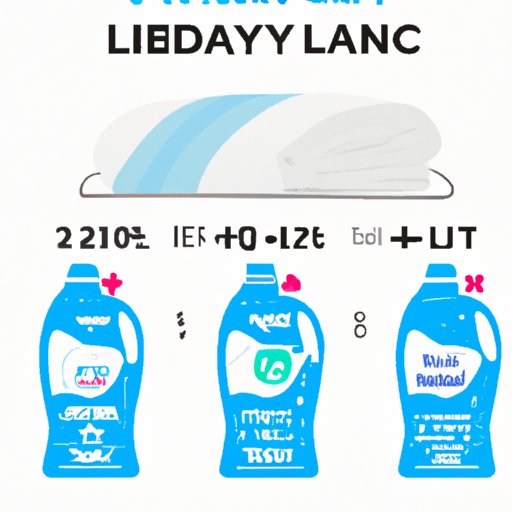Introduction
Laundry detergent is a cleaning agent used to remove dirt, mud, and other stains from clothes. It can come in either liquid or powder form, and it’s essential for anyone who wants to keep their clothes looking good. There are many different types of detergents available, so it’s important to understand what each one does and how to use them properly.

Understanding What Different Ingredients Do
Detergents contain various ingredients that all serve a purpose. Here’s an overview of the most common ones:
Surfactants
Surfactants are the core ingredient in laundry detergents. They act as a surfactant, meaning they reduce the surface tension between two substances, allowing them to mix more easily. This helps to loosen dirt, mud, and other stains from clothes.
Enzymes
Enzymes are protein molecules that help break down complex molecules into simpler ones. They’re often added to laundry detergents to help break down proteins that may be found in sweat, blood, or other organic materials. This makes it easier to remove these tough stains.
Brighteners
Brighteners are chemicals added to laundry detergents to make colors look brighter and whites whiter. They work by reflecting light off of the fibers in fabrics, creating a brighter appearance.
Fragrances
Fragrances are added to laundry detergents to give clothes a pleasant scent. These fragrances can be natural or synthetic, and they can range from floral to fruity or even woodsy.
Reading and Following Instructions on the Labels
Before using any laundry detergent, it’s important to read the label and follow the instructions. This will help ensure that you’re using the right product for your clothes and that you’re using it correctly.
Water Temperature
Most detergents should be used with warm or cold water, but some are designed for use with hot water. Pay attention to the label to make sure you’re using the correct water temperature for the detergent you’ve chosen.
Amount of Detergent to Use
The amount of detergent you need to use depends on the size of the load and the type of fabric you’re washing. The label will usually provide guidelines on how much detergent to use for each type of load.

Selecting the Right Detergent for Your Clothes
In addition to reading and following the instructions on the label, it’s important to select the right detergent for your clothes. Here are some things to consider when making your choice:
Consider Your Fabric Type
Different fabrics require different detergents. For example, delicate fabrics such as silk or wool require a milder detergent than sturdy fabrics like cotton or denim. Be sure to choose the right detergent for your fabric type.
Determine the Load Size
The size of the load also affects the type of detergent you should use. If you’re washing a smaller load, you may want to use a concentrated detergent, which is more effective in small amounts. On the other hand, larger loads may require a more powerful detergent.

Using the Proper Amount of Detergent
Once you’ve selected the right detergent for your clothes, it’s important to use the proper amount. Overusing detergent can cause residue to build up on clothes over time, while underusing detergent can leave clothes feeling stiff and unclean.
Follow Manufacturer’s Directions
It’s best to follow the instructions on the label when it comes to the amount of detergent to use. This will ensure that you’re using the right amount for your load size and fabric type.
Measure Out Appropriately
If you’re not sure how much detergent to use, it’s best to measure it out. Many detergents come with measuring cups or spoons, which can help you get the right amount every time. Or if you’re using liquid detergent, use the lines inside the cap to measure out the appropriate amount.
Pre-treating Stains Before Washing
Stains can be difficult to remove once they’ve set in, so it’s important to pre-treat them before washing. This will help to ensure that the stain is removed in the wash cycle.
Treat as Soon as Possible
It’s best to treat a stain as soon as possible after it occurs. If you wait too long, the stain may become harder to remove. So be sure to treat the stain right away.
Choose the Right Stain Remover
When treating a stain, it’s important to choose the right stain remover. There are many different types available, so it’s best to do some research beforehand to determine which one is best for the particular stain you’re trying to remove.
Checking for Colorfastness
It’s also important to check for colorfastness before using any laundry detergent. This will help to prevent colors from running or fading during the wash cycle.
Test a Small Area of Fabric
To check for colorfastness, it’s best to test a small area of the fabric first. Dip a cotton swab in the detergent and dab it onto a hidden spot on the fabric. If the color doesn’t fade or run, then the fabric is likely colorfast.
Use a Colorfast Detergent
If the fabric isn’t colorfast, it’s best to use a colorfast detergent. This type of detergent is specifically designed to prevent colors from running or fading during the wash cycle.
Conclusion
Using laundry detergent properly is essential for keeping your clothes looking their best. To do this, it’s important to understand the different ingredients in detergents, read and follow the instructions on the label, select the right detergent for your clothes, use the proper amount of detergent, pre-treat stains before washing, and check for colorfastness. By taking these steps, you’ll be able to keep your clothes looking clean and fresh.


